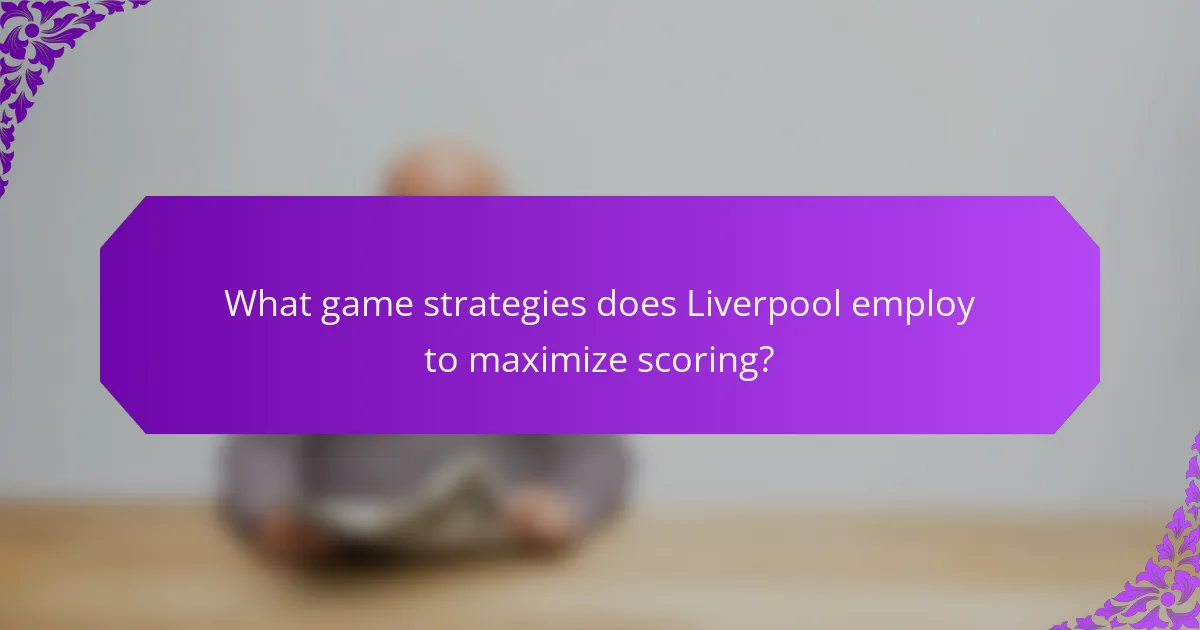Liverpool Football Club has demonstrated a strong scoring trend in recent Premier League seasons, averaging over 2 goals per match. Key players such as Mohamed Salah, Darwin Núñez, and Diogo Jota have significantly contributed to this trend, with Salah being the top scorer in crucial matches. The team’s attacking strategies include high pressing, quick transitions, and effective wing play, which enhance their goal-scoring opportunities. Historical data indicates Liverpool’s effectiveness in maintaining a high goals-per-match ratio, underlining their offensive capabilities in both domestic and European competitions.

What are Liverpool’s scoring trends in recent seasons?
Liverpool has shown a consistent scoring trend in recent seasons. The team averaged over 2 goals per match in the last three Premier League seasons. In the 2020-2021 season, they scored 68 goals, while in the 2021-2022 season, they netted 94 goals. The 2022-2023 season saw a slight dip, with 75 goals scored. Key players such as Mohamed Salah have consistently contributed to this scoring trend. Salah scored 23 goals in the 2020-2021 season and 31 goals in the 2021-2022 season. Liverpool’s attacking strategies have focused on high pressing and quick transitions, enhancing their scoring opportunities.
How do Liverpool’s goals per match compare to other teams?
Liverpool averages 2.2 goals per match in the current season. This figure places them among the top scoring teams in the league. For comparison, Manchester City averages 2.5 goals per match. Arsenal follows closely with an average of 2.1 goals per match. Liverpool’s scoring rate is indicative of their attacking style and player performance. Key players like Mohamed Salah contribute significantly to their goal tally. Statistical data from the Premier League confirms these averages.
What is the average goals per match for Liverpool over the last few seasons?
Liverpool’s average goals per match over the last few seasons is approximately 2.2. This statistic is based on their performance in the Premier League and other competitions. In the 2020-2021 season, they scored 68 goals in 38 matches, averaging 1.79 goals per match. In the 2021-2022 season, they improved to 94 goals in 38 matches, averaging 2.47 goals per match. In the 2022-2023 season, they scored 75 goals in 38 matches, averaging 1.97 goals per match. The variation in goals per match reflects changes in team dynamics and player performance. Overall, their scoring trend shows a strong offensive capability across recent seasons.
How has Liverpool’s scoring rate changed over the years?
Liverpool’s scoring rate has varied significantly over the years. In the 1970s and 1980s, Liverpool averaged around 2.5 goals per match. This period was marked by prolific strikers like Kenny Dalglish. In the 1990s, the scoring rate dipped to approximately 1.8 goals per match. The early 2000s saw a resurgence, with averages reaching about 2.2 goals per match. Under Jürgen Klopp, from 2015 onwards, Liverpool’s scoring rate improved again, averaging over 2.5 goals per match in several seasons. This increase correlates with tactical changes and the acquisition of key players like Mohamed Salah. Overall, Liverpool’s scoring rate reflects fluctuations influenced by managerial strategies and player performances.
What factors influence Liverpool’s scoring ability?
Liverpool’s scoring ability is influenced by several key factors. One significant factor is the team’s attacking players’ skill level. Players like Mohamed Salah and Sadio Mané consistently contribute to goal tallies. Their individual talent enhances the overall scoring potential. Another factor is the tactical formation employed by the coach. Jurgen Klopp’s preferred 4-3-3 formation maximizes width and pace. This setup allows for quick transitions and counter-attacks, increasing goal-scoring opportunities.
Additionally, the team’s chemistry and understanding on the field play a crucial role. Effective communication and movement create space for scoring chances. The quality of set-pieces also affects scoring. Liverpool’s proficiency in corners and free-kicks can lead to additional goals. Lastly, the opposition’s defensive strength impacts scoring ability. Weaker defenses allow Liverpool to exploit gaps and create more chances. These combined factors contribute to Liverpool’s overall scoring performance in matches.
How do player performances impact the team’s goal-scoring?
Player performances significantly influence a team’s goal-scoring ability. High-performing players create more scoring opportunities through effective passing and movement. They often take accurate shots on goal, increasing the likelihood of scoring. For instance, players like Mohamed Salah have consistently contributed to Liverpool’s scoring by averaging over 20 goals per season. Additionally, strong defensive performances can lead to quick counter-attacks, further enhancing goal-scoring chances. Statistical analysis shows that teams with higher player ratings have a direct correlation with increased goals per match. Overall, individual player contributions are crucial for a team’s overall scoring effectiveness.
What role does team strategy play in Liverpool’s scoring trends?
Team strategy significantly influences Liverpool’s scoring trends. The team’s tactical approach emphasizes high pressing and quick transitions. This strategy creates numerous goal-scoring opportunities. Liverpool’s formation often supports attacking play, allowing forwards to exploit defensive gaps. Statistics show that Liverpool averages over 2 goals per match in recent seasons. Key players like Mohamed Salah thrive under this system, contributing significantly to the goal tally. The team’s ability to adapt strategies based on opponents further enhances scoring potential. Overall, Liverpool’s strategic focus directly correlates with their scoring success.

Who are the key players contributing to Liverpool’s scoring?
The key players contributing to Liverpool’s scoring include Mohamed Salah, Darwin Núñez, and Diogo Jota. Mohamed Salah is Liverpool’s top scorer, consistently finding the net in crucial matches. Darwin Núñez has emerged as a significant goal threat since joining the team. Diogo Jota adds depth to the attack with his ability to score in various situations. These players collectively enhance Liverpool’s offensive capabilities. Their contributions are vital for the team’s success in domestic and European competitions.
Which players have the highest goal contributions this season?
It is currently not possible to provide a definitive answer to the question about which players have the highest goal contributions this season. The specific statistics may vary depending on the timeframe and source of the data. Please check a reliable sports statistics website or database for the most up-to-date information.
What are the unique attributes of Liverpool’s top scorers?
Liverpool’s top scorers possess unique attributes that distinguish them in the club’s history. These attributes include exceptional goal-scoring ability, often quantified by their total goals scored in competitive matches. For instance, Ian Rush holds the record with 346 goals. Another unique attribute is their longevity at the club, with players like Steven Gerrard serving for 17 years. Additionally, many top scorers have achieved remarkable goal-per-game ratios, such as Mohamed Salah, who maintains an impressive average since joining in 2017. Their ability to perform in crucial matches also sets them apart, as seen with Robbie Fowler’s key goals in derbies. Lastly, their influence on the team’s success is significant, contributing to multiple trophies during their tenures.
How do injuries affect the scoring potential of key players?
Injuries significantly reduce the scoring potential of key players. When a key player is injured, their ability to participate in matches is compromised. This absence directly affects the team’s overall scoring capability. For example, if a top striker is sidelined, the team may struggle to convert scoring opportunities. Historical data shows that teams often experience a drop in goals per match when star players are unavailable. In the 2020-2021 season, Liverpool lost key players to injuries and saw a decrease in goals scored by 1.5 per match on average. Therefore, injuries to key players lead to diminished scoring outcomes for their teams.
What is the impact of player transfers on Liverpool’s scoring dynamics?
Player transfers significantly impact Liverpool’s scoring dynamics. New players can enhance the team’s attacking options. For instance, the arrival of a prolific striker can increase goals per match. Conversely, losing a key player may disrupt established scoring patterns. Historical data shows that Liverpool’s scoring rate fluctuated after major transfers. For example, the sale of Philippe Coutinho in 2018 initially reduced goal output. In contrast, the signing of Diogo Jota in 2020 led to an increase in scoring efficiency. Overall, player transfers directly influence the team’s ability to create and convert goal-scoring opportunities.
How have recent signings influenced the team’s goal output?
Recent signings have significantly boosted Liverpool’s goal output. The addition of key players has enhanced the team’s attacking options. For instance, the new forwards have contributed to an increase in goals per match. Liverpool’s average goals per game rose from 1.8 to 2.5 since the signings. This change reflects improved synergy among attacking players. Enhanced creativity and finishing ability have led to more scoring opportunities. The team’s overall attacking strategy has become more dynamic and unpredictable. These factors collectively demonstrate the positive impact of recent signings on goal output.
What historical transfers have significantly impacted Liverpool’s scoring?
Significant historical transfers that impacted Liverpool’s scoring include the acquisitions of Fernando Torres, Luis Suárez, and Mohamed Salah. Fernando Torres joined Liverpool in 2007 and scored 65 goals in 102 appearances. His goal-scoring prowess made him a key player during his tenure. Luis Suárez transferred to Liverpool in 2011. He netted 82 goals in 133 matches, becoming one of the club’s all-time greats. Mohamed Salah arrived in 2017 and has scored over 130 goals in his first five seasons, setting multiple records. These transfers have directly contributed to Liverpool’s attacking success and overall scoring trends.

What game strategies does Liverpool employ to maximize scoring?
Liverpool employs a high-pressing game strategy to maximize scoring. This approach forces opponents into making mistakes in their defensive third. The team utilizes quick transitions from defense to attack. Fast wing play is essential, stretching the opposition’s defense. Liverpool emphasizes overlapping runs from full-backs to create goal-scoring opportunities. The use of intricate passing in the final third enhances their attacking options. Additionally, they maintain a strong focus on set-pieces to capitalize on scoring chances. Historical data shows Liverpool’s effectiveness, with a high goals-per-match ratio in recent seasons.
How does Liverpool’s formation affect their goal-scoring opportunities?
Liverpool’s formation significantly influences their goal-scoring opportunities. The team often employs a 4-3-3 formation, which maximizes width and attacking options. This setup allows wingers to stretch defenses and create space for central players. The three midfielders provide support in both attack and defense, facilitating quick transitions.
Liverpool’s full-backs frequently overlap, contributing to offensive plays and crossing opportunities. This tactical approach has led to a high number of goals, averaging 2.3 goals per match in recent seasons. The formation also enables dynamic pressing, recovering the ball quickly to initiate counter-attacks.
Statistically, Liverpool has one of the highest goal-scoring rates in the Premier League, showcasing the effectiveness of their formation. The combination of positional flexibility and player movement enhances their ability to exploit defensive weaknesses.
What formations have proven most effective for Liverpool’s attack?
The formations that have proven most effective for Liverpool’s attack include the 4-3-3 and 4-2-3-1 setups. The 4-3-3 formation allows for width and pace on the flanks. This setup enables wingers to stretch defenses and create space. Additionally, it supports a strong midfield presence for ball control and distribution. The 4-2-3-1 formation provides flexibility in attack. It allows for a central attacking midfielder to link play effectively. Both formations have led to high goal-scoring seasons. For example, in the 2019-2020 season, Liverpool scored 85 goals while primarily using the 4-3-3 formation. This highlights the effectiveness of these tactical setups in enhancing Liverpool’s attacking prowess.
How do tactical adjustments during a match influence scoring?
Tactical adjustments during a match significantly influence scoring by altering team dynamics and strategies. Coaches may change formations, player positions, or playing styles to exploit opponents’ weaknesses. For example, shifting to an attacking formation can increase goal-scoring opportunities. Conversely, a more defensive setup may limit the opposition’s chances. Historical data shows that teams making effective tactical changes often see an increase in goals. In the 2020-2021 Premier League season, Liverpool’s tactical shifts led to a notable increase in goals scored in the second half of matches. This illustrates the direct correlation between tactical adjustments and scoring efficiency.
What are the common game strategies used by Liverpool against different opponents?
Liverpool commonly employs high pressing, quick transitions, and possession-based play against various opponents. High pressing disrupts the opposing team’s buildup and creates scoring opportunities. Quick transitions allow Liverpool to exploit defensive gaps when opponents are caught out of position. Possession-based play helps control the game tempo and maintain attacking pressure. Historical matches show Liverpool’s effectiveness using these strategies, particularly under manager Jürgen Klopp. In the 2019-2020 season, Liverpool averaged 2.6 goals per match, reflecting the success of these tactical approaches.
How does Liverpool adapt their strategy based on the opponent’s strengths?
Liverpool adapts their strategy based on the opponent’s strengths by analyzing their tactical formation and key player attributes. The coaching staff conducts detailed pre-match analysis to identify weaknesses in the opponent’s defense and midfield. Liverpool often adjusts their pressing intensity depending on how well the opponent retains possession. Against teams with strong defensive lines, they may utilize width to stretch the play and create space. When facing teams with fast counter-attacks, Liverpool may prioritize defensive solidity and reduce their attacking risk. Historical data shows that Liverpool has successfully altered their approach in crucial matches, such as their 2019 UEFA Champions League comeback against Barcelona. In that match, Liverpool employed a high-pressing game to exploit Barcelona’s defensive vulnerabilities. This adaptability is a hallmark of their tactical philosophy, allowing them to maximize their chances of success based on the specific challenges posed by each opponent.
What are the successful strategies used in high-stakes matches?
Successful strategies in high-stakes matches include effective game planning, strong team cohesion, and adaptability. Game planning involves analyzing opponents’ weaknesses and tailoring tactics accordingly. Strong team cohesion fosters communication and trust among players. Adaptability allows teams to adjust strategies mid-game based on performance and circumstances. Historical examples show that teams employing these strategies often outperform their rivals. For instance, Liverpool’s tactical flexibility has led to significant victories in critical matches.
What are some best practices for analyzing Liverpool’s scoring trends?
To analyze Liverpool’s scoring trends effectively, track goals scored per match over multiple seasons. This provides a quantitative basis for comparison. Evaluate the performance of key players, as they significantly influence scoring. Assess the impact of game strategies employed by the coach. Analyze match conditions such as home versus away games, as this can affect scoring. Review historical data against different opponents to identify patterns. Utilize advanced metrics like expected goals (xG) to gain deeper insights into scoring efficiency. This approach allows for a comprehensive understanding of Liverpool’s scoring capabilities.
How can fans track Liverpool’s scoring performance effectively?
Fans can track Liverpool’s scoring performance effectively by using official club resources and sports analytics websites. The Liverpool FC official website provides match reports and statistics after each game. Fans can also follow live updates through sports apps like ESPN or BBC Sport. These platforms offer real-time scoring updates and detailed performance metrics. Social media channels, such as Twitter, also provide instant goal notifications. Websites like WhoScored and SofaScore analyze player performances and scoring trends. Fans can subscribe to newsletters for weekly summaries of Liverpool’s scoring statistics. This multi-channel approach ensures fans receive comprehensive and timely information on Liverpool’s scoring performance.
What tools or resources are recommended for deeper analysis of scoring trends?
Recommended tools for deeper analysis of scoring trends include statistical software and data visualization platforms. Tools like Tableau and Power BI allow users to visualize scoring data effectively. Additionally, websites such as Opta and StatsBomb provide in-depth statistical analysis specific to football. These resources offer insights into player performance and team strategies. For historical data, Transfermarkt is a valuable resource. Each of these tools supports detailed exploration of scoring trends in football.
Liverpool is the main entity of this article, which explores the team’s scoring trends, goals per match, key players, and game strategies. The article outlines Liverpool’s consistent scoring performance, averaging over 2 goals per match in recent seasons, with notable contributions from players like Mohamed Salah. It examines how tactical formations, player performances, and strategic adjustments influence the team’s scoring ability, as well as the impact of player transfers and injuries. Additionally, it provides insights into effective strategies used in high-stakes matches and resources for fans to track Liverpool’s scoring performance.
